Best Tripods: Give your camera a rock-solid base
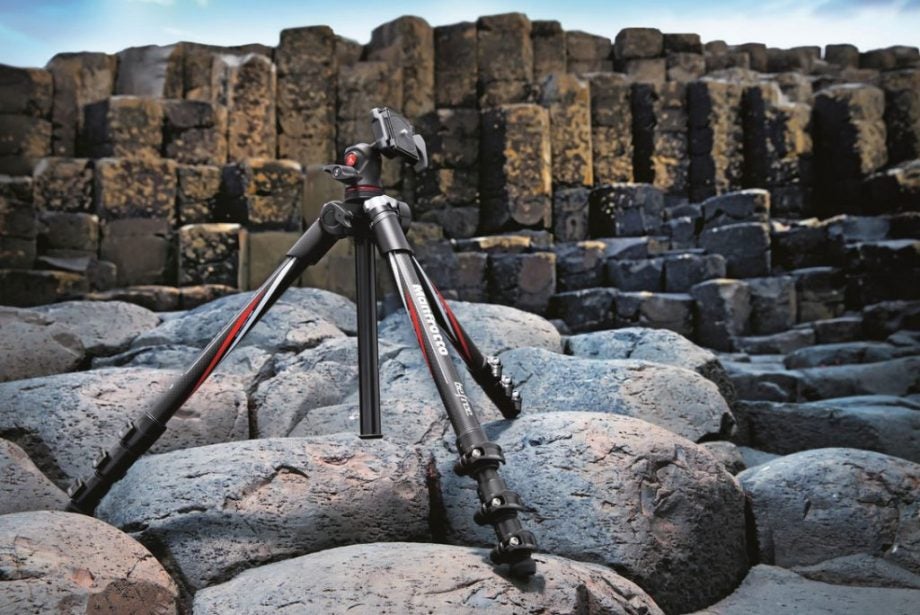
A decent tripod can open the door to a number of creative techniques. Here we reveal the best tripods and what to look for when choosing one.
If you want to improve the quality of your images and try out new photographic techniques, a decent tripod should be at the top of your shopping list. Not only will it enable you to obtain sharper images, but you’ll also be able to shoot in a wider range of conditions – such as when ambient light levels are too low to shoot handheld.
Better still, a tripod will allow you to experiment with a range of creative techniques such as long-exposure photography, which can be used to capture movement and turn clouds, rivers and the sea silky smooth.
Video enthusiasts will also find plenty of advantages in working with a tripod. Not least because a tripod will enable you to capture smoother and more professional-looking footage, without the shakiness commonly associated with amateur videos shot by hand.
The best tripod we tested was the Gitzo GT1544T Series 1 6X Traveler. This tripod is beautifully designed, highly portable and lightweight, without compromising on functionality. However, if you’re looking for something more affordable, the Benro Slim would make a great alternative. This budget tripod is unbelievably lightweight, as it is made of carbon-fibre, and is a good sturdy design.
Related: Best cameras
1. Manfrotto 190 Go!
The best value tripod for serious outdoor photographers
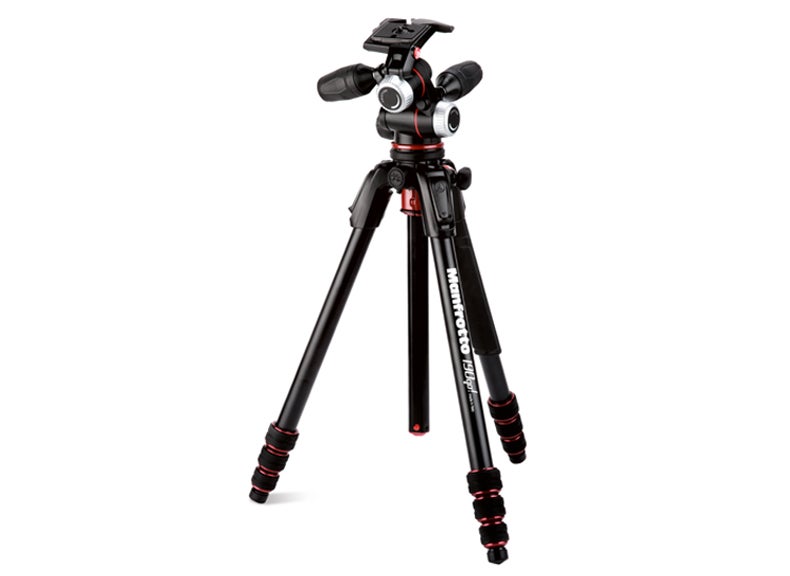
Pros:
- Robust
- Small and light
- Adjustable centre column
Cons:
- Reasonably expensive
Why we liked the Manfrotto 190 Go!
The Manfrotto 190 tripod series has been around for many years, but the 190 Go! marks the first time that Manfrotto has used rotational leg locks instead of lever locks.
The 190 Go! is also the lightest and smallest model to grace the 190 range to date. That said, it’s still robust enough to support an enthusiast-level DSLR and 70-200mm f/2.8 lens.
Elsewhere, it features an Easy Link socket that can be used to attach accessories such as an LED light or reflector. The 190 Go! also comes with an adjustable centre column that can be set to 90 degrees to help with creative angles, along with four individual leg angles that provide plenty of flexibility.
Latest live deals
2. Vanguard VE02 235 CB
A fine choice for travelling light
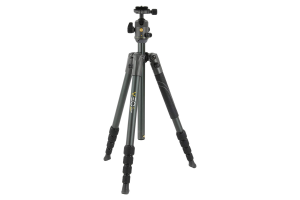
Pros:
- Very lightweight and portable
- Great tripod head
- Short centre column included for shooting at ground level
Cons:
- None
Why we liked the Vanguard VE02 235 CB
With cameras featuring ever-improving high-ISO performance and increasingly effective image stabilisation, it’s tempting to think you can get away without using a tripod. But there are still times when nothing else will do and if you don’t want to lug around a heavy, full-size support, then the Vanguard VE02 235CB is a really capable, lightweight option.
This mid-sized model in the VEO range uses five-section carbon-fibre legs to keep the weight and packed size to a minimum. Like many other tripods the legs fold around the head, but Vanguard uses a unique design where the column rotates 180-degrees downwards, which is far quicker than folding all the legs upwards as. with other travel tripods.
Set-up is really quick and the legs can be set independently to either 20-degree, 45-degree or 80-degree angles using large, easy-to-operate press-in locking buttons. The VEO 2 BH-50 head that comes in the kit is also much better than you’ll find on most other lightweight tripods. It even has adjustable ball friction, which is pretty rare at this price, and makes it easier to work with different size cameras and lenses.
This is a really neat tripod that’s easy to set up and is capable of supporting surprising weight – it’ll happily support a mid-range DSLR or larger mirrorless camera with a medium telephoto zoom. It’s most stable with the centre column dropped down, which gives a working height just shy of 120cm, so if you need to support the camera at eye-level it’ll likely be too small. That aside, it’s a great choice for when you need to travel light.
Latest live deals
3. Benro Slim
A fantastic budget option
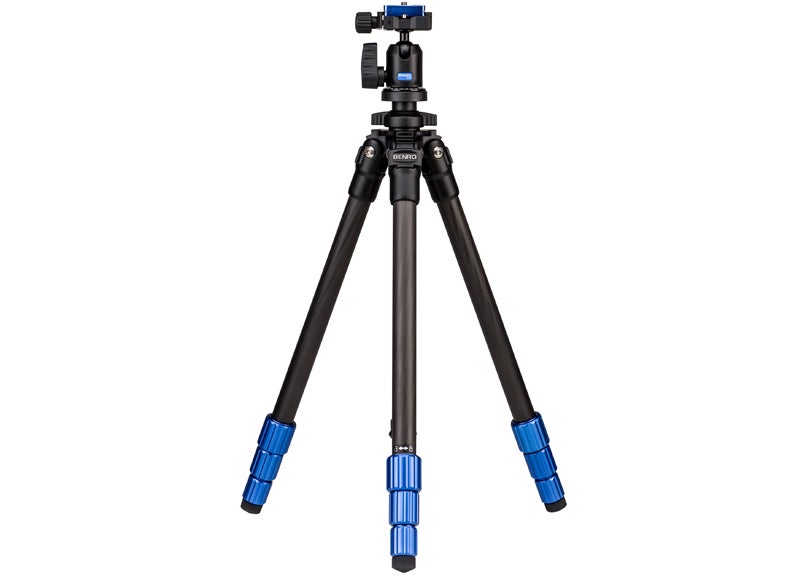
Pros:
- Ultra light carbon-fibre
- Highly portable
- Excellent price point
Cons:
- Relatively pared-down model
- Lacks additional features
Why we liked the Benro Slim
Seeing a carbon-fibre tripod launched for just £120 might appear too good to be true. But that’s exactly what Benro has achieved with this Slim model (TSL08CN00). This isn’t for just the leg set, either, as a ball-and-socket head is included in the price.
So how has Benro achieved this improbable feat? The answer is by making a pared-down model that eschews many of the embellishments that are common elsewhere. You don’t get reverse-folding legs for a shorter packed length, or a detachable monopod, or foam grips on the legs. It’s just a good old-fashioned tripod.
That’s not to say the design is basic, though. The four-section carbon-fibre legs can be set independently to three angles, and the twist leg locks can all be undone together in a single half-turn motion. All the controls are big and chunky, so they’re easy to lock up.
Benro’s bundled ball head has a neat design, with twin grooves for switching the camera to portrait format. However, the usefulness of the graduated panoramic base is somewhat compromised by it sharing a lock with the main ball mechanism.
The design has a couple of other drawbacks, too. The twist locks certainly look good in blue, but I’m not convinced I’d want to handle them in cold weather – a rubberised finish would be more practical. There’s no provision to use a short centre column, either, which limits how close you can get to the ground to 40cm.
This Benro Slim carbon-fibre tripod kit has a few negative points, but they’re easy to forgive for the bargain price. Overall, it’s a great budget option for when you need to travel light.
Latest live deals
4. Vanguard Veo 204AB Traveller
An affordable aluminium option for travellers
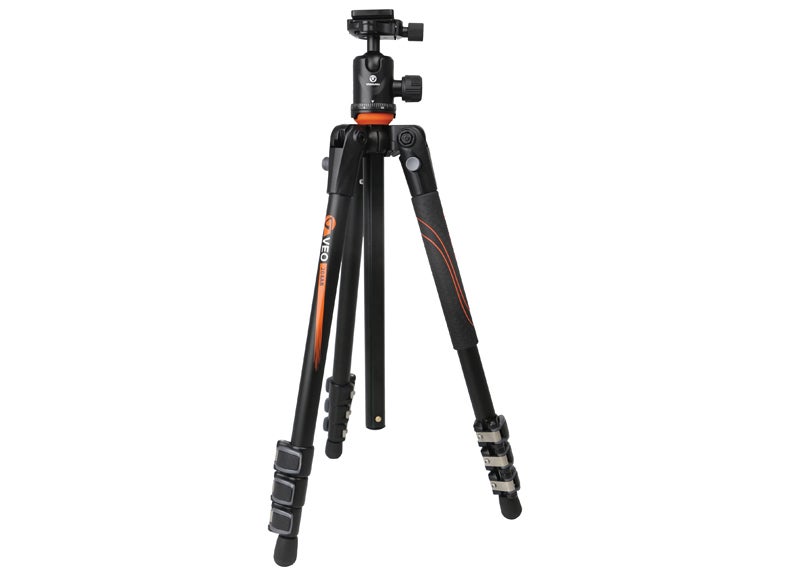
Pros:
- Rapid rotation centre column
- Excellent value
- Very affordable
Cons:
- Basic features in comparison to higher end models
Why we liked the Vanguard Veo 204AB Traveller
The Veo 204AB is a travel tripod, featuring a rapid rotation centre column design that allows it to be easily inverted without having to unscrew anything or remove it.
This allows you to keep the ball head attached and to quickly set up and pack away the tripod. It also has robust lever-style leg locks, three leg angle positions, anti-slip rubberised feet with inset spikes, a rubberised carrying handle on one of the legs, and an additional shortened centre column for extra-low shooting – which all fits into a supplied tripod bag.
The supplied TBH-45 ball head comes with a bubble level and panoramic markings around the perimeter. All in all, excellent value.
Latest live deals
5. Manfrotto Befree Advanced
Not the lightest or cheapest, but a tough and reliable tripod
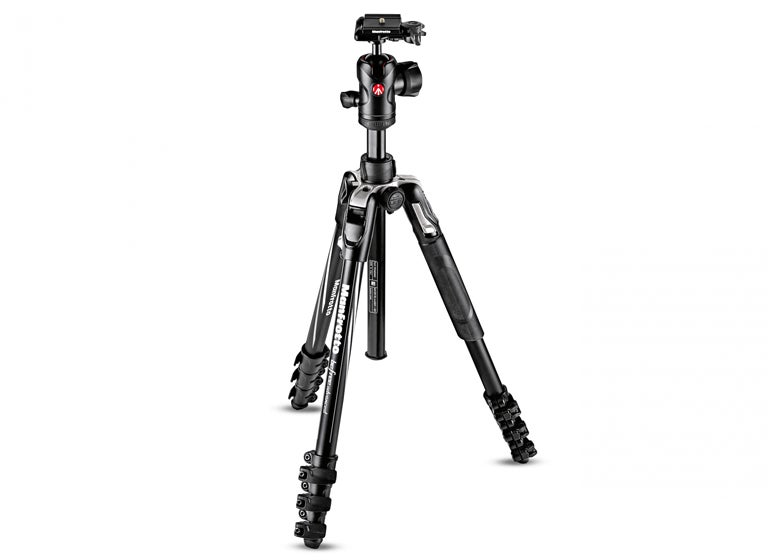
Pros:
- Excellent ball head design
- Robust and stable
Cons:
- Not very light
- Reasonably expensive
Why we liked the Manfrotto Befree Advanced
Manfrotto’s Befree tripod series is a good option if you’d like a compact four-section tripod to take on your travels. Here we’re looking at the Befree Advanced, which is designed for serious hobbyists on the go.
It’s supplied with Manfrotto’s excellent 494 centre ball head that features three controls to lock the ball head, adjust the friction and pan the camera by 360 degrees. The 200PL Pro plate is RC2 and Arca-swiss compatible; however, it’s not as easily secured as Manfrotto’s older style 200PL quick-release plates and benefits from being tightened with an allen key to prevent it loosening.
The lever locks on our sample proved to be very strong, clamping each leg section tightly with no sign of slipping. The legs can be set to three angle positions, guaranteeing full shooting versatility for all the creative ideas that can emerge outdoors.
Overall, the Befree Advanced is a solidly made four-section aluminium tripod. It doesn’t win any awards for being the lightest or cheapest travel tripod available, but it is robust, hard wearing and certainly up to the task of providing a stable base on all the different types of terrain a photographer on is likely to come across when traveling.
Latest live deals
6. Gitzo GT1544T Series 1 6X Traveler
A premium, super-strong option for bigger cameras
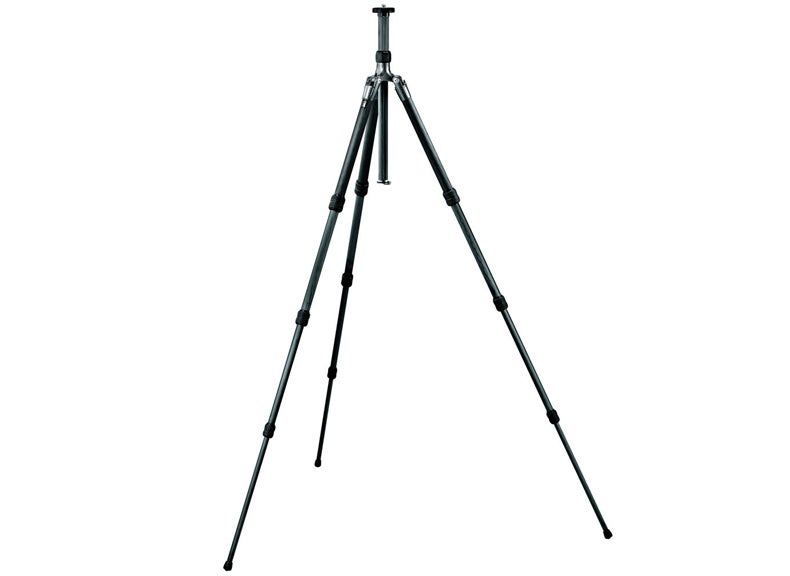
Pros:
- Ultra light carbon-fibre
- Excellent leg-folding design
- Highly portable
Cons:
- Extremely high price point
Why we liked the Gitzo GT1544T Series 1 6X Traveler
Gitzo is owned by the same parent company as Manfrotto and specialises in high-end tripods for serious enthusiasts and professional photographers.
The GT1544T is designed for those who require a highly portable tripod that doesn’t unduly compromise durability or functionality. To this end, each of its leg sections are constructed from Gitzo’s bespoke 6x carbon-fibre weave, which ensures excellent rigidity, and helps keep the overall weight down.
Gitzo’s patented leg-folding design allows each leg to be folded back by 180 degrees, allowing the legs to wholly envelop both the centre column and a small tripod head (not supplied). It can bear up to 8kg, and has a maximum extended height of 142cm.
7. Velbon Ultra 655
A versatile, mid-range option
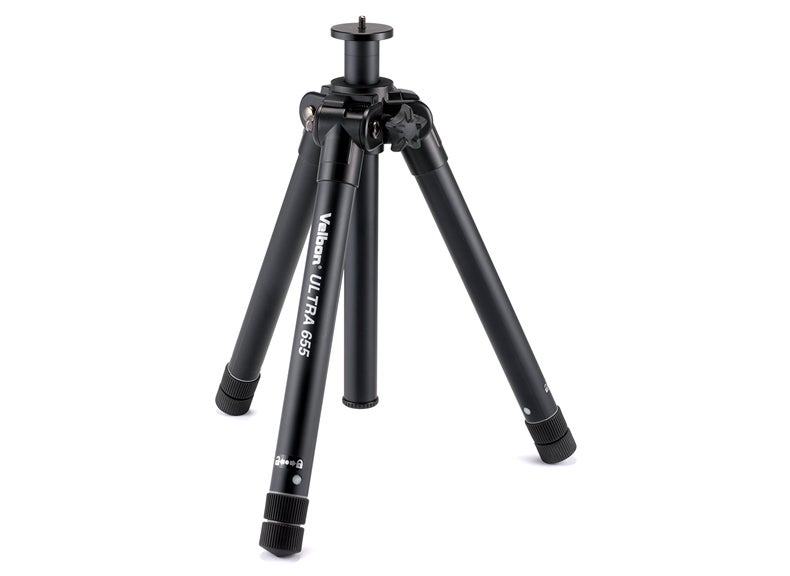
Pros:
- Very affordable
- Removable lower-section of centre column
- Good range of height
Cons:
- Better for lighter cameras
Why we liked the Velbon Ultra 655
Velbon makes decent budget tripods, well suited to occasional use with lighter camera and lens combinations.
The recently announced Ultra 655 is the flagship model in its ‘Compact System’ range and is perfectly adequate for a mid-range DSLR and standard zoom.
It utilises Velbon’s proprietary Trunion Shaft System (TSS), in which each leg extends the entire inside length of the outer leg casing to provide a strong, stable maximum height of 154cm, along with an impressively compact 37.2cm when folded down.
The lower portion of the centre column can be removed, allowing you to set the tripod to just 13.3cm with the legs fully splayed.
Latest live deals
8. Sirui Easy Traveler ET-2204
A solid, well-designed tripod that’s excellent value for money
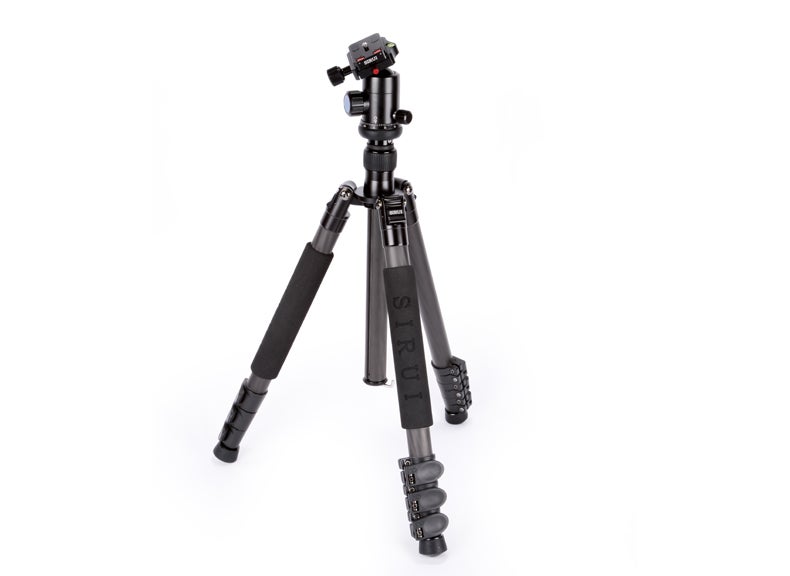
Pros:
- Weather adaptable features
- Shorter centre column provided
- Foldable legs
Cons:
- High price point
Why we liked the Sirui Easy Traveler ET-2204
The ET-2204 comes with an E-20 ball head mount, and employs lever-style leg locks that are easy to open and close even while wearing gloves – handy on cold days.
Each leg can be set to one of three angles: 21, 52 and 81 degrees, while a shorter centre column is also supplied, allowing you to shoot from a minimum height of 13.5cm.
There’s also an equipment hook on the centre column, non-slip rubber feet and two foam leg warmers for easier use in cold or wet weather. The legs can be folded back by 180 degrees to enclose the centre column and E-20 ball head for a closed length of 43cm.
Sirui also offers the ET-2004 in aluminium for about £100 less.
Latest live deals
Best Tripods Round Up
- Manfrotto 190 Go! – The best value tripod for serious outdoor photographers
- Vanguard VE02 235 CB – A fine choice for travelling light
- Benro Slim – A fantastic budget option
- Vanguard Veo 204AB Traveller – An affordable aluminium option for travellers
- Manfrotto Befree Advanced – Not the lightest or cheapest, but a tough and reliable tripod
- Gitzo GT1544T Series 1 6X Traveler – A premium, super-strong option for bigger cameras
- Velbon Ultra 655 – A versatile, mid-range option
- Sirui Easy Traveler ET-2204 – A solid, well-designed tripod that’s excellent value for money
Which is the right tripod for you?
Maximum Load Capacity, maximum extendable height, and minimum height
One of the important things to consider when deciding what type of tripod is right for you is the weight of the camera equipment you intend to mount on it. This isn’t as difficult as it might sound, as most manufacturers helpfully specify a ‘maximum load capacity’ that refers to how much weight each individual tripod is designed to bear.
Two other important specifications to look out for are: ‘maximum extendable height’, and ‘minimum height’. The first refers to the overall height of the tripod when the legs and the centre column are fully extended, while the latter refers to the minimum height off the ground you can set it to.
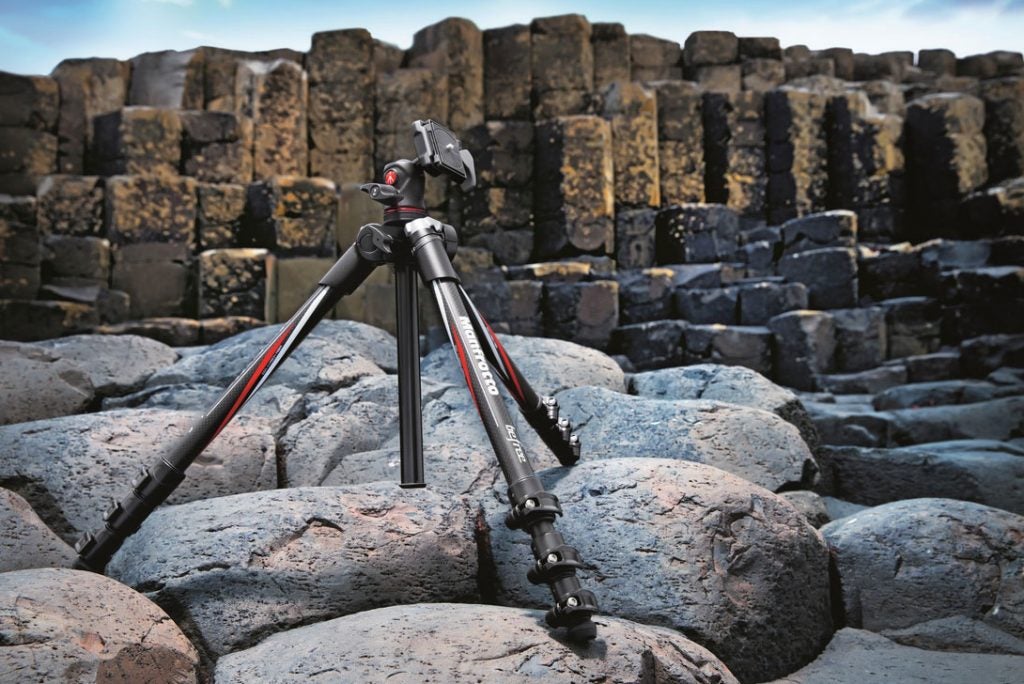
Of course, different types of photographer will have different priorities. Travel tripods, such as those found in the Manfrotto BeFree and Velbon Ultra ranges, are popular, as they offer a practical combination of low weight and compact dimensions, making them ideal for globe-trotting photographers and hiking enthusiasts alike.
At the other end of the spectrum you’ll find larger, heavier tripods designed primarily for studio use. These are primarily concerned with providing a stable platform at extended heights for heavier professional-grade cameras and optics.
Choosing a tripod head
Tripod head advise
Buying a set of tripod legs is only half the story: you’ll also need a tripod head to sit on top of the legs and attach a camera to.
Ball heads use a ball and socket design that allows for quick adjustment in all directions. This makes them ideal when you need to frame your image in a hurry, but they can be a bit clumsy when it comes to fine-tuning your compositions. Hydrostatic ball heads alleviate this problem to a degree by adding independent resistance controls. As you would expect, they do cost quite a bit more than regular ball heads, though.
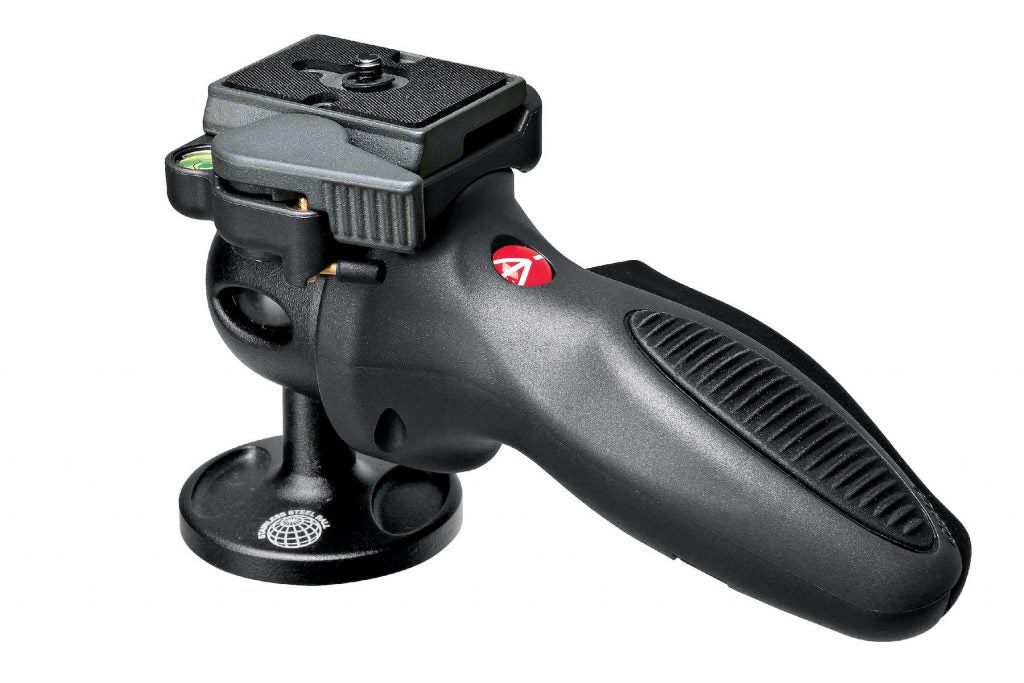
The Manfrotto Light Duty Grip Ball Head features friction control and comes complete with a quick-release camera plate
Basic pan-and-tilt, or ‘two-way’, heads allow you to control vertical and horizontal movement of the camera. While they can be useful for video capture, three-way heads are more popular with stills photographers as they include an additional hinge that allows you to flip your camera onto its side so that you can shoot in landscape or portrait orientation.
Other more specialist tripod heads include geared tripod heads that employ a set of geared dials (rather than lockable levers) to offer precise control over each axis. Last but not least, gimbal heads are designed for use with large telephoto lenses. Gimbal heads offer fluid movement in all directions and are popular with wildlife and sports photographers.


